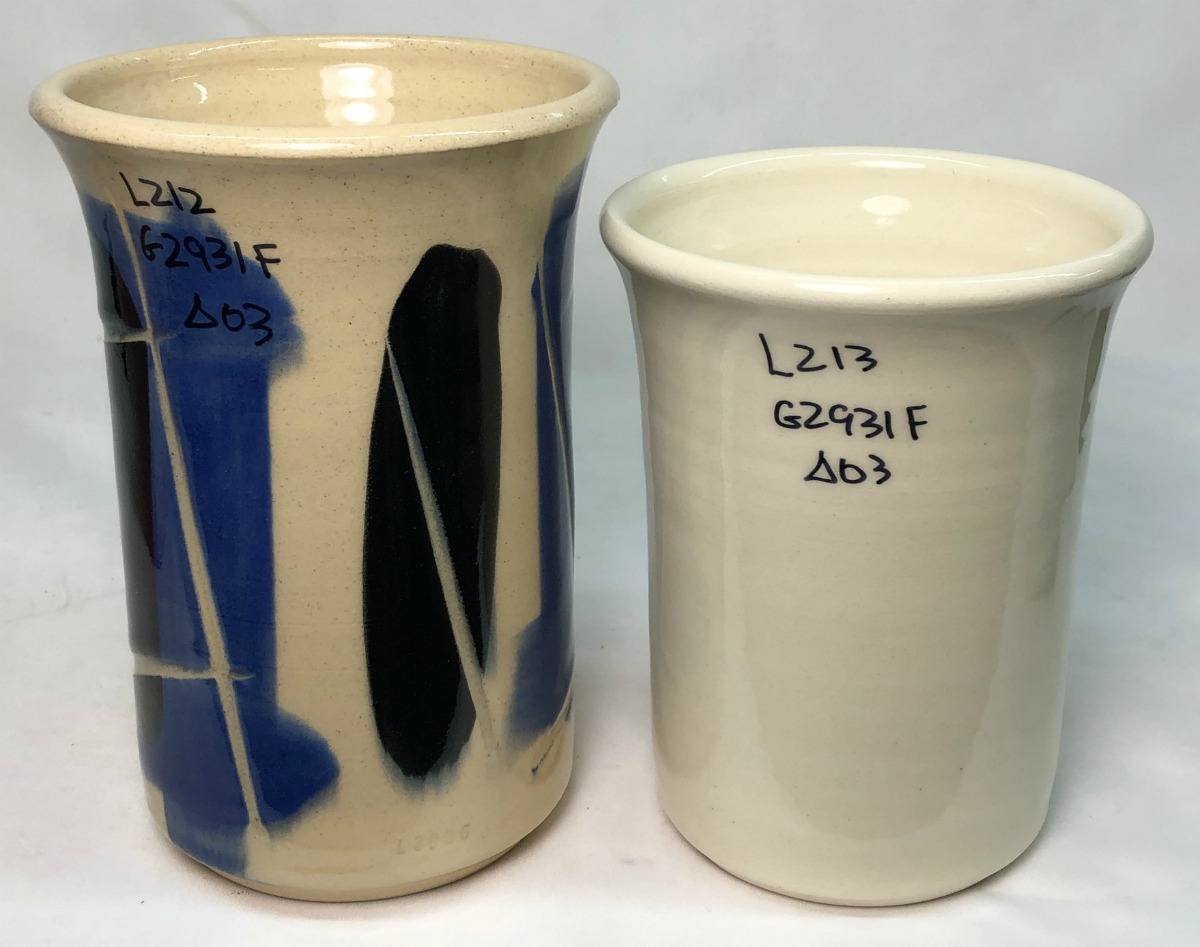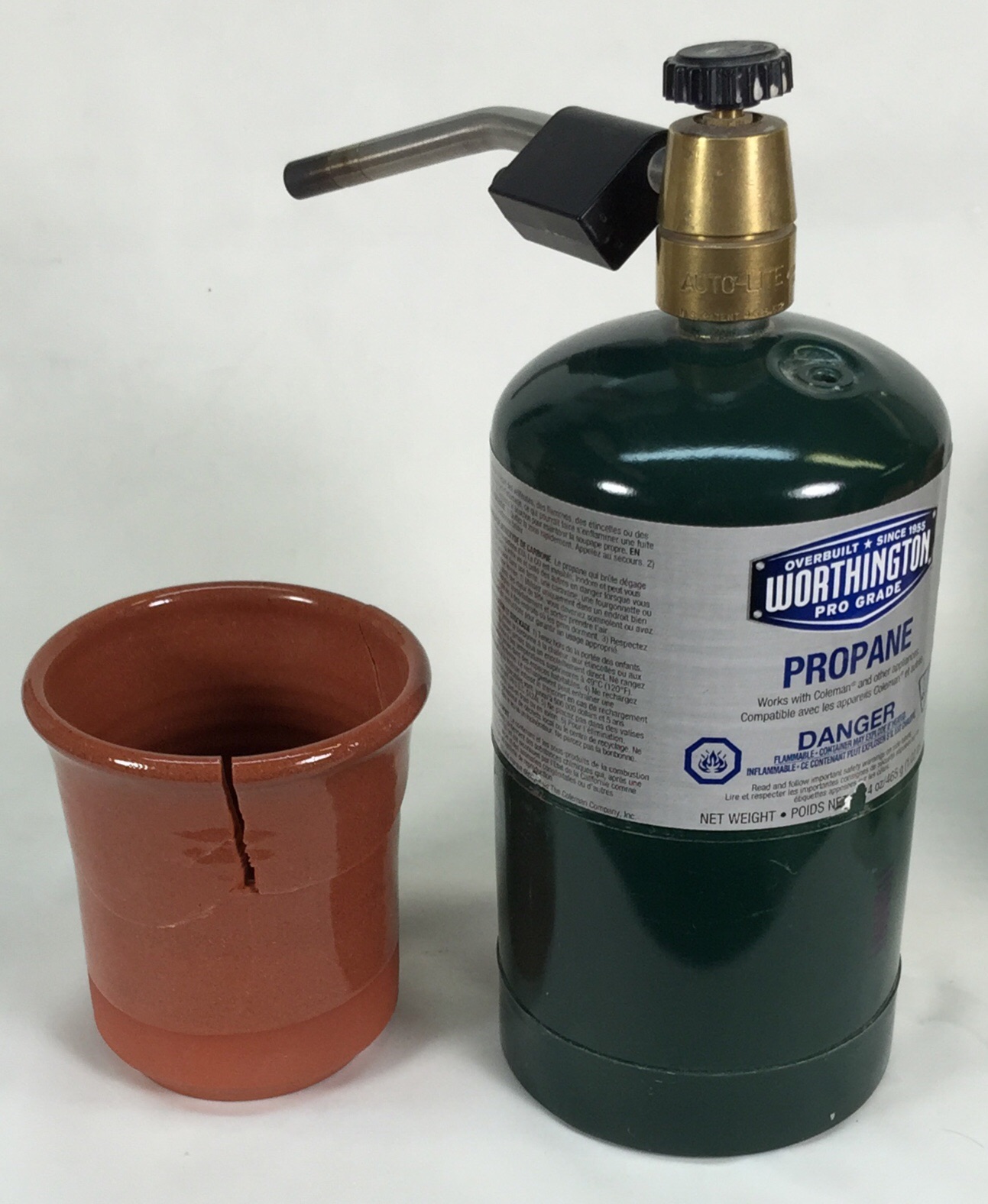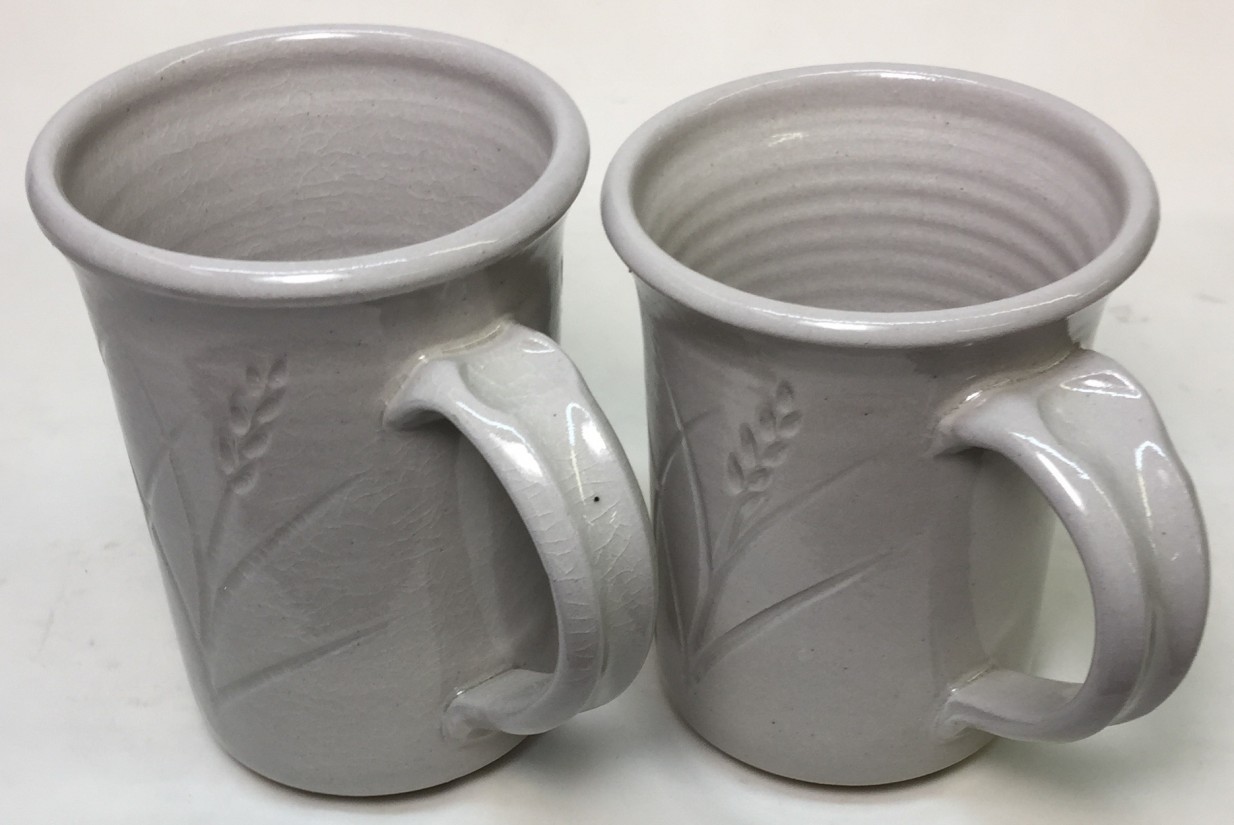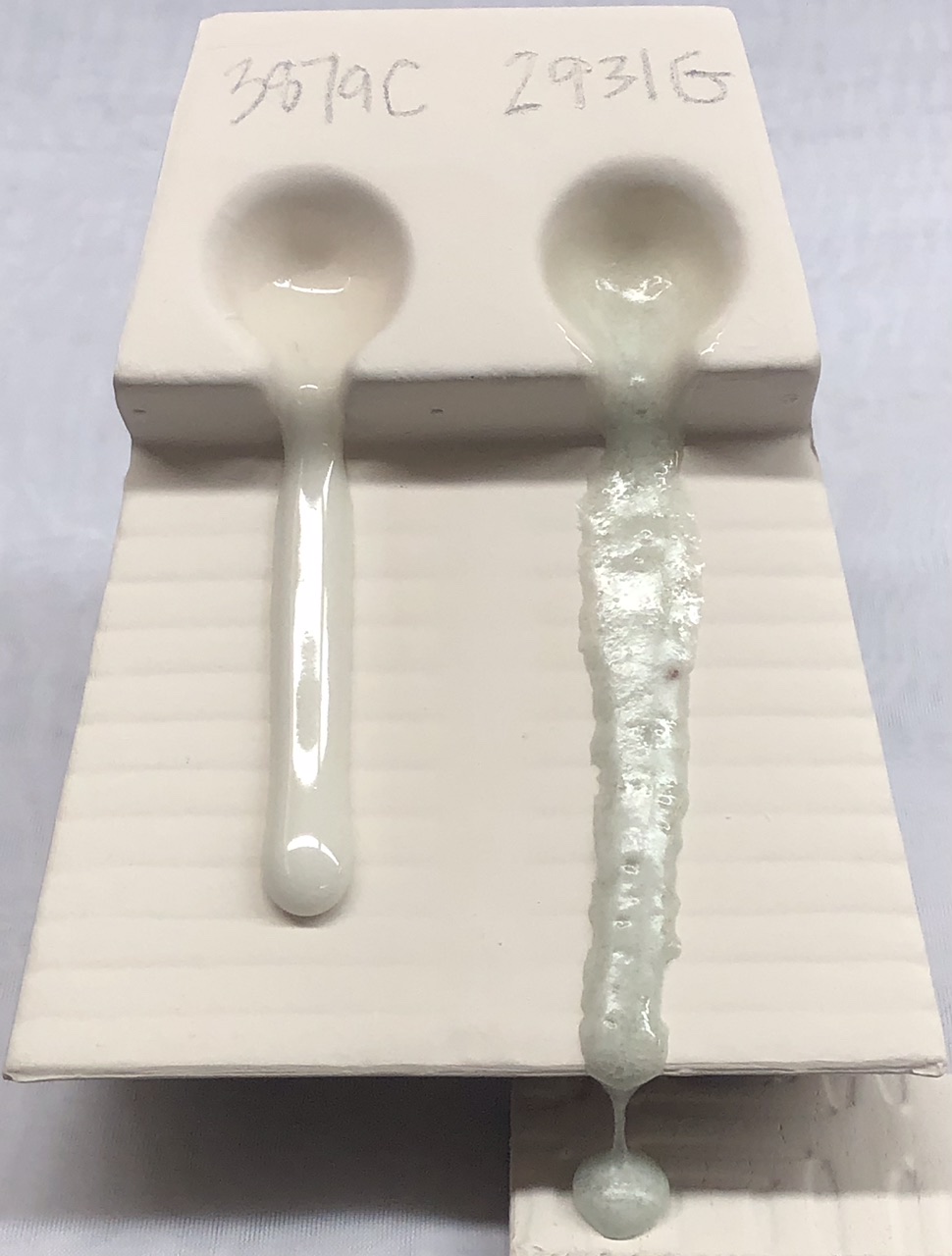Zero3 Ulexite Transparent Glaze
For use with the Zero3 body and engobe
|
Code # G2931F |
Batch # -2 |
| Materials | Amt |
|---|---|
| EPK | 27.000 |
| Silica | 7.000 |
| Ulexite | 29.000 |
| Ferro Frit 3249 | 9.000 |
| Wollastonite | 9.000 |
| Ferro Frit 3110 | 19.000 |
Total:100.00
Auto Unity Formula
|
Si:Al: 5.8:1 7.4 (Molar:7.5) 14.3 Cost 0.00 per kg |
Notes
This recipe converts the popular Worthington Clear Gerstley-Borate-based recipe into something much easier to use. While Worthington melts to a good clear it has serious gelling problems (characteristic of Gerstley Borate). Normal frits cannot easily source this high level of B2O3 so I have employed Ulexite to augment (a mineral similar to GB yet gels only slightly). Another issue with Worthington is shivering and fracturing of ware when glazed only on the inside (its thermal expansion was too low). This recipe also raises thermal expansion (by adding Na2O), the result is a glaze that fits a much wider range of bodies. Worthington also has clouding issues, this yields a more crystal clear, defect free fired result.
While reading this page, note that I later found that it was better to use frits to source the boron (rather than Ulexite or Gerstley Borate). That recipe is G2931K, it has a higher and lower expansion version also. So view this recipe as simply on the path from Worthington Clear to ultimately the Frit-based transparent, G2931K.
Dipping ware in Zero3 Transparent is just so much easier than trying to paint on than commercial, slow drying clears. It produces a slurry with very nice suspension, drying and application properties. It naturally gels (at around 1.4 SG in our lab). It applies very well in an even layer to low or high porosity bisque (the gel makes it hang on without running or dripping). However the 1.4 specific gravity (which is lower than most stoneware glazes) means that it dries slower if bisque is dense.
As a clear overglaze to finish your decorated ware, this glaze has a number of advantages over commercial clear glazes:
-It is much less expensive so it is practical to have a large pail of it so that pieces can be easily dip-glazed (using dipping tongs).
-It behaves like stoneware glazes, it suspends well and applies in an even layer that can dry to handling stage is seconds.
-It fires to a better crystal clear.
-Since the recipe is known, and contains no toxic materials, you can more confidently assure retailers that it is safe; all underglaze color decoration is isolated from any contact with food or drink by this glaze.
-It is compatible with most underglaze colors (including pinks).
Pay special attention to the soak-soak-slow cool firing schedule for this glaze, especially if your clay body is not fine grained.
Pictures
Terrastone, L215

The successful firing of these mugs represents two years of testing to learn how to get a crystal clear glaze and how to create slips that dry and fire bond well! The firing schedule is very important: Cone 03 soak-rise-soak-slowcool. Slips are bright colored (they contain only 10% stains).
Left: L3786E Plainsman Terrastone test mix with L3724M vitreous red slip with G2931F glaze. Wax resist exposes portions of the red slip which flashes near the glaze boundary.
Center: Terrastone with L3685U vitreous white slip inside and brushed on (and 10% stained versions of it brushed on) with G2931F glaze.
Right: L3724M vitreous red body with L3685U engobe (and stained versions of it) with G2931F glaze.
Shivers on L212

L213 with G2931F glaze cone 04, 03, 02

Boiling water, ice water tested. None crazed.
The cone 03 one was still good after a year.
Zero3 body with G2931F Zero3 glaze

The F version of the glaze employs Ulexite to source the boron (instead of frits). These Zero3 stoneware mugs were fired to cone 03 with underglazes. The right mug has the Zero3 engobe inside (under the glaze).
G2931F (left), G2931G (right) on buffstone

Cone 03. Did boiling water, ice water test on both. F crazes (notice the piece is waterlogged). G does not. Buffstone has a high porosity at this temperature so glazes must fit well.
G2931F on F100, Buffstone, L212 and L215

Out of the kiln all fit. However it crazed on buffstone after boiling water, ice water test (use 2931G instead). The others are good. L212 crazes at cone 04.
Firing temperature is important for Zero3 glaze

This is G2931F on Plainsman Buffstone, L213, F100, L215. First column is cone 04, center is cone 03, right is cone 02. All exited the kiln without crazing except Buffstone at cone 04.
We subjected all of them to a 300F:IceWater thermal shock.
Buffstone crazed on all of them.
L215 and L212 Cone 04 crazed.
L213 was good but later the glaze was found to be under excessive compression, subject to shivering over underglazes.
At cone 02 there are some dimples and defects.
G2931F vs G2931K - Melted balls at cone 03

F, the Ulexite version, is obviously bubbling more, the percolation is causing the melt to spread out more on the tile. On the flow test is was less fluid.
G2931F vs. G2931K on Polar Ice Low Fire

2931F was the Ulexite flused version of this recipe. The F survived three boil:ice cycles and 1 300F:ice cycle without crazing or shivering.
The K is slightly smoother, tiny dimples in the surface are fewer. It is also applied thicker.
G2931F vs 2931K flow test

G2931F on Zero3 Porcelain

The mug was decorated with underglazes at the leather hard stage, then bisque fired to 1650F, then dip-glazed and fired using a cone 03 drop-and-hold firing schedule. This glaze is exceptionally brilliant and clear, it transmits the color of the underglazes better than any other glaze at any other temperature I have seen. This glaze was later upgraded to one having the same chemistry but a higher frit content and firing even better, G2931K.
G2931F on L212, L213 - After one year

No crazing. Even after two years.
A dazzling ultra gloss transparent glaze!
Testdata
LDW - LOI/Density/Water Content
| WWGT | DWGT | H2O | LOI | DENS | |
| 1 | 21.86 | 11.23 | 48.6% |
XML (to paste into Insight)
<?xml version="1.0"?> <recipes version="1.0" encoding="UTF-8"> <recipe name="Zero3 Ulexite Transparent Glaze" keywords="For use with the Zero3 body and engobe" id="75426" key="gGAFfdJe" date="2022-01-24" codenum="G2931F" picturebasename=""> <recipelines> <recipeline material="EPK" amount="27.000" tolerance=""/> <recipeline material="Silica" amount="7.000" tolerance=""/> <recipeline material="Ulexite" amount="29.000" tolerance=""/> <recipeline material="Ferro Frit 3249" amount="9.000" tolerance=""/> <recipeline material="Wollastonite" amount="9.000" tolerance=""/> <recipeline material="Ferro Frit 3110" amount="19.000" tolerance=""/> </recipelines> </recipe> </recipes>
Born: 2014-03-19, Modified: 2022-01-24 19:16:09
Zero3 G Low Expansion Low Fire Clear
|
Code # G2931G |
Batch # -2 |
| Materials | Amt | |
|---|---|---|
| EPK | 27.296 | 27.03% |
| Silica | 13.265 | 13.13% |
| Ulexite | 26.085 | 25.83% |
| Ferro Frit 3249 | 18.622 | 18.44% |
| Wollastonite | 13.180 | 13.05% |
| Zinc Oxide | 2.551 | 2.53% |
Total:101.00
Auto Unity Formula
|
Si:Al: 5.4:1 6.2 (Molar:6.3) 13.2 Cost 0.00 per kg |
Notes
This is a low-expansion version of the Zero3 Clear glaze (code G2931K). While that glaze fits the vitreous Zero3 porcelain and stoneware and non-vitreous bodies containing talc (like Plainsman L212, L215), it crazes on others (e.g. Plainsman TerraStone, BuffStone, L210).
This version, G2931G, drops expansion drastically, from 7.4 down to 6.2 (it is a follow up to G2931B which was 6.5, this adds 0.1 ZnO at the expense of KNaO and CaO). It is thus possible adjust thermal expansion of either recipe by adding some of the other (to deal with shivering or crazing you encounter).
The soak:soak:slowdrop firing is critical for a defect free surface. This sacrifices some surface brilliance compared to G2931K. The chemistry cannot be produced using common North American frits, so Ulexite is employed (the original recipe from which the Zero3 glaze system was derived, Worthington Clear, was high in Gerstley Borate and made a jellied mess in the bucket, very difficult to use).
Do not try to use this with too little water. Mix it to 1.4 specific gravity and add vinegar or Epsom salts to gel it so that it stops moving (after vigorous stirring) in less than 2 seconds. It naturally gels so little vinegar should be needed. It applies very well to low or high porosity bisque (in a very thin layer if needed), it does not drip or move but does take a minute to dry.
The soak:soak:slowdrop firing schedule is critical to a defect-free surface.
Pictures
Terra cotta and thermal shock

This terra cotta cup is glazed with G2931G clear glaze and fired at cone 03. It survives 25 seconds under direct flame against the sidewall before a crack occurs. Typical porcelains and stonewares would survive 5-10 seconds!
This is a key advantage of earthenware. Sudden changes in temperature cause localized thermal expansion, this produces tension that easily cracks most ceramics. But the porous nature of earthenware absorbs it much better.
P6318 Terrastone with G2931G Clear Glaze cone 03

G2931G clear shivering on 3724N1 (fritted terra cotta) at cone 03

G2931F (left), G2931G (right) on buffstone

Cone 03. Did boiling water, ice water test on both. F crazes (notice the piece is waterlogged). G does not. Buffstone has a high porosity at this temperature so glazes must fit well.
P580 Pioneer cone 10R bisqued with 2931F and G glazes

F crazes. G does not. Both need to be applied thicker.
P580 with cone 03 clear vs cone 10 clear

G2931G clear on cone 10R bisqued piece (left).
G1947U cone 10R glaze (right).
The G need a tiny amount of blue stain.
Cone 04 Melt flow comparison G3879C vs G2931G

XML (to paste into Insight)
<?xml version="1.0"?> <recipes version="1.0" encoding="UTF-8"> <recipe name="Zero3 G Low Expansion Low Fire Clear" id="76114" key="chJFDjfg" date="2021-09-11" codenum="G2931G" picturebasename=""> <recipelines> <recipeline material="EPK" amount="27.296" tolerance=""/> <recipeline material="Silica" amount="13.265" tolerance=""/> <recipeline material="Ulexite" amount="26.085" tolerance=""/> <recipeline material="Ferro Frit 3249" amount="18.622" tolerance=""/> <recipeline material="Wollastonite" amount="13.180" tolerance=""/> <recipeline material="Zinc Oxide" amount="2.551" tolerance=""/> </recipelines> </recipe> </recipes>
Born: 2014-03-19, Modified: 2021-09-11 20:11:26
